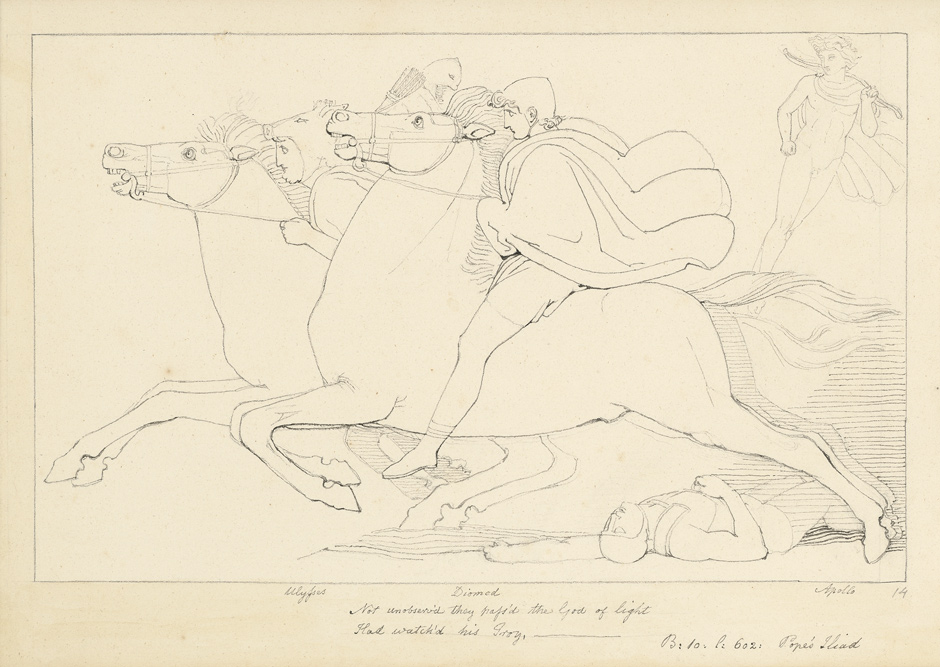Loading the page ...
John Flaxman
(1755 York – 1826 London)
Odysseus and Diomedes on Horseback. Pen and grey-black ink over graphite. 23.5 x 29.3 cm. Inscribed in the artist’s own hand: “Ulysses Diomed / Not unobserv’d they pass’d the God of light / Had watch’d his Troy. / B: 10. l: 602: Pope’s Iliad”. Circa 1794. Watermark: J. Whatman 1794.
This characteristic pen-and-ink drawing by John Flaxman is distinguished by its masterful, synthetic composition and the purist beauty of the linework. Flaxman has illustrated a scene from the Trojan War as it is described in Homer’s epic poem the Iliad, for which he has relied on Alexander Pope’s translation of the original ancient text. In clear and visually highly effective outlines Flaxman portrays the two Greek heroes, Odysseus and Diomedes, as they race away on their horses under the watchful eye of Apollo. While the stylistic inspiration of ancient Greek models, especially the relief sculptures on the Parthenon frieze in Athens, is readily apparent, the radical reduction of the form shows that Flaxman was also deeply indebted to the neo-classical ideal of form prevalent in his day.
John Flaxman, a sculptor and draughtsman, studied under his father of the same name who worked as a plaster cast maker. He had a weak constitution, could not walk properly as a child and depended on crutches. Throughout his life he suffered from an abnormal curvature of the spine. Flaxman was a child prodigy. In 1767, when he was just twelve years of age, he exhibited plaster models at the Free Society of Artists. The famous painter, George Romney, was among his patrons and he was on friendly terms with the leading intellectuals and artists of this time such as William Blake und Thomas Stothard. From 1775 Flaxman designed decorative motifs for the factory of Wedgwood and Bentley, which helped him to further his knowledge of ancient Greek art. Of crucial importance for Flaxman’s artistic development, however, was his stay in Rome, which was made possible by a grant from Wedgwood and lasted from 1787 to 1794. Flaxman’s diary entries, letters and drawings from those years testify to the intensity with which he explored not only the grandeur of antiquity, but also the art of the so-called Italian Primitives and the great masters of the High Renaissance. At the same time he maintained close ties with prominent collectors and antiquarian booksellers such as Sir William Hamilton and Pierre François d’Hancarville and associated with prominent fellow artists like the sculptor, Antonio Canova, the French architect, Charles Percier, and the Irish painter, Gavin Hamilton. Thus, far from being isolated in Rome, Flaxman was very much au fait with the artistic trends of his time and drew inspiration from all the relevant sources. Apart from sculptural projects the artist was also active as a draughtsman in Rome and, relying on his literary education, made illustrations of works by Homer, Aischylos and Dante. Ultimately it was this sideline that paved the way for his international breakthrough. In 1792 he received a commission from his mentor, Georgina Hare-Taylor, to illustrate Homer’s Iliad and Odyssey. Flaxman began work on this prestigious project in December 1792 and spent a whole exacting year completing the outline illustrations for the Iliad. The models he drew were accurately and faithfully transferred to the engraving medium by the Italian engraver, Tomaso Piroli, and the first Italian edition of 1793 proved an outstanding success, thus finally establishing Flaxman as an artist and spreading his name throughout Europe. The numerous subsequent editions provide eloquent testimony to his standing. An English edition appeared in London in 1795 immediately after Flaxman’s return to England. Another edition, extended by eleven prints, was issued in 1805 and a German edition published in Leipzig in 1804.
Flaxman made the present drawing around 1794 as part of his work on the Iliad illustrations. Ultimately, however, it was never used as an engraving model. A second, stylistically very similar version is in the collection of the Royal Academy of Arts in London (Inv. No. 03/3290). In all likelihood the present drawing was made in Rome, for it was in the possession of the renowned banker, art collector and connoisseur, Thomas Hope (1769–1831), one of Flaxman’s main patrons during his stay in Rome. In 1917 the New York art dealers, Scott & Fowles, acquired a substantial ensemble of drawings by Flaxman when Hope’s collection came up for auction at his residence in Deepdene in Surrey. See the Catalogue of an Exhibition of Original Drawings by John Flaxmann, R. A. Scott & Fowles, New York 1918, No. 14. Two other drawings for the Iliad from this source, with comparable annotations and numbering, are in the Metropolitan Museum in New York (Inv. Nos. 18.132.1, 18.141.3).
